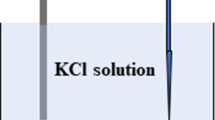Summary
This study was undertaken in order to determine directly the rates of K leakage (J K) out of the tips of microelectrodes into a solution of 100 mM KCl (approximating the K concentration of the cell interior) and to relate these rates to the concentration of the filling solution and the tip resistance. The values ofJ K for electrodes filled with 3m KCl having resistances of 16 and 30 MΩ (when measured in 3m KCl) were 10 and 5.5 fmol/sec, respectively. When the same electrodes were filled with 0.5m KCl, the resistances (measured in 0.5m KCl) increased to 62 and 115 MΩ, respectively, andJ K fell to 1.8 and 1.0 fmol/sec, respectively. These values are in reasonable agreement with what would be expected from theoretical considerations if leakage of KCl were the result of diffusion plus convective flow due to the hydrostatic pressure of the filling solution.
We conclude that K leakage out of microelectrodes filled with 3m KCl is unnecessarily high; leakage can be reduced fivefold by filling electrodes with 0.5m KCl without incurring significant increases in tip or diffusion potentials or unmanageable tip resistances.
Finally, the lowest rate of K leakage observed (1 fmol/sec) is still very considerable for the case of animal cells with an intracellular volume of approximately 1 pl and a K content of approximately 100 fmol. The finding of stable intracellular potentials, often for many minutes, in some tissues suggests that K which enters the cell rapidly diffuses into neighboring cells via high conductance intercellular communications.
Similar content being viewed by others
References
Coombs, J.S., Eccles, J.C., Fatt, P. 1955. The specific ionic conductances and the ionic movements across the motoneuronal membrane that produce the inhibitory post-synaptic potential.J. Physiol. (London) 130:326–373
Firth, D.R., DeFelice, L.J. 1971. Electrical resistance and volume flow in glass microelectrodes.Can. J. Physiol. Pharmacol. 49:436–447
Frömter, E. 1972. The route of passive ion movement through the epithelium ofNecturus gallbladder.J. Membrane Biol. 8:259–301
Geisler, C.D., Lightfoot, E.N., Schmidt, F., Sy, F. 1972. Diffusion effects of liquid-filled micropipettes: A pseudobinary analysis of electrolyte leakage.IEEE Trans. Biomed. Eng. 19:372
Helman, S.I., Nagel, W., Fisher, R.S. 1979. Ouabain on active transepithelial sodium transport in frog skin.J. Gen. Physiol. 74:105–127
Hodgkin, A.L. 1951. The ionic basis of electrical, activity, in nerve and muscle.Biol. Rev. 25:339–409
Isenberg, G. 1979. Risk and advantages of using strongly beveled microelectrodes for physiological studies in cardiac purkinje fibers.Pfluegers. Arch. 380:91–98
Krnjevic, K., Mitchell, J.F., Szerb, J.C. 1963. Determination of iontophoretic release of acetylcholine from micropipettes.J. Physiol. (London) 165:421–436
Ling, G., Gerard, R.W. 1949. The normal membrane potential of frog sartorius fibers.J. Cell. Comp. Physiol. 34:383–396
Nastuk, W.L., Hodgkin, A.L. 1950. The electrical activity of single muscle fibers.J. Cell. Comp. Physiol. 35:39–73
Nelson, D.J., Ehrenfeld, J., Lindermann, B. 1978. Volume changes and potential artifacts of epithelial cells of frog skin following impalement with microelectrodes filled with 3m KCl.J. Membrane Biol. 40:91–119
Palmer, L.G., Civan, M.M. 1977. Distribution of Na+, K+ and Cl− between nucleus and cytoplasm inChironomus salivary gland cells.J. Membrane Biol. 33:41–61
Robinson, R.A., Stokes, R.H. 1959. Electrolyte Solutions. 2nd Ed. Academic Press, New York
Author information
Authors and Affiliations
Rights and permissions
About this article
Cite this article
Fromm, M., Schultz, S.G. Some properties of KCl-filled microelectrodes: Correlation of potassium “leakage” with tip resistance. J. Membrain Biol. 62, 239–244 (1981). https://doi.org/10.1007/BF01998169
Received:
Issue Date:
DOI: https://doi.org/10.1007/BF01998169




